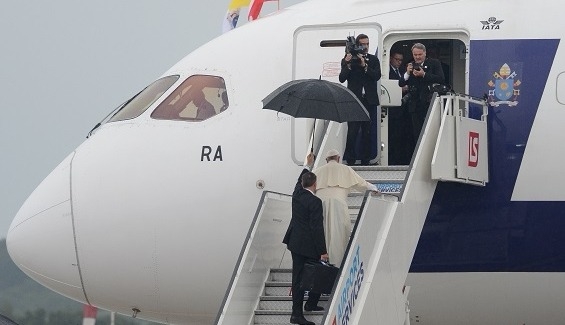In the past few years – since the ill-fated decision of Benedict XVI about his abdication – we have experienced something we could call a fast course about the essence of the papacy. Its latest part is the “Filial Correction” (Correctio filialis) addressed to Pope Francis, signed by sixty eminent representatives of the Catholic life (laymen and clergymen), which contains a request to repudiate opinions being overtly in contradiction with the perennial teaching of the Church.
But earlier there were “dubia” signed by four cardinals, a confession of faith signed by a large group of theologians, both clergymen and laymen, confirming the perennial teaching of the Church about the indissolubility of marriage. There was also a Filial appeal signed by almost 900 000 Catholics from the whole world, addressed to Pope Francis between two sessions of the Synod on the Family, in which they asked the Successor of St. Peter to confirm the perennial teaching of the Church on the permanence of sacramental marriage and therefore impossibility of admitting the divorced and civilly remarried to Holy Communion.
Wesprzyj nas już teraz!
On the other hand we can hear from Francis himself and his closest associates some words which might suggest an attempt to adopt not only a “new paradigm” by the Church (to outline briefly: “pastoral work, only pastoral work, the doctrine doesn’t count”), but within it also by the papacy in particular. We can hear from him, whom – as the successor of St. Peter – the Savior himself entrusted with a mission of strengthening his brethren in the faith – words that express as much his powerlessness as cheerful disavowing that responsibility: “Who am I to judge?” (about people surrendering to sexual deviations), after all the time of “a listening magisterium” has come (Cardinal Walter Kasper). Go into all the world and listen to all the nations – this is that “new paradigm” of the Church.
So we live in times of abdication and this is a really new paradigm. The tired face of Benedict XVI and his more and more terrible justifications of his abdication – this is the most distinctive picture of our times. For first on the day he announced his decision of putting away the keys of St. Peter we could hear that “both strength of mind and body” had deteriorated in him. That the last one deteriorates – unfortunately that’s something normal but that the strength of mind deteriorated in the Vicar of Christ – that’s a terrible thing. However even more terrible was something Benedict XVI added in his conversation with Peter Seewald that the true reason was the fact that the Pope was supposed to be present at the World Youth Day in Rio de Janeiro and Benedict was not able to cope with that task. That is why the Pope from Germany made an unprecedented decision in the history of the Church, a decision which has not been without consequences – wreaking havoc in the life of the Church. Frankly speaking: there would be no Pope Francis with all his agenda of the “new paradigm” of the Church if not for the disastrous decision to abdicate made by Benedict XVI. Even more: I wish Benedict hadn’t freed the traditional liturgy but had remained on St. Peter’s Chair.
The abdication, which has assumed a form of ceremonial retirement (“Pope Emeritus” – what a degrading name! Similar to “Apostle Emeritus”), after all gives a lesson about the functionality of St. Peter’s Office. It means a notion that the Pope must be physically fit as he has to manage a huge international organization; as an important director in an international corporation. Of course with all that notion it means also smuggling, nolens volens, an erroneous doctrine about the essence of the Church which is not a large international non-governmental organization but one mystical Body of Christ. And the same in case of the papacy. It is something more than just the Pope. That’s an office of the Vicar of Christ, the Successor of the Prince of Apostles. It’s a Petrine ministry which does not require being ubiquitous (although thanks to modern technology it may be done without any difficulty and irrespective of one’s age) but staying and strengthening his brethren in the Faith. That’s enough.
Finally the papacy means the majesty of history. Not only the history of the Church. Also people being far away from Catholicism have been able to see it. As Thomas Macaulay, a nineteenth century British historian (a protestant one) wrote: “There is not, and there never was on this earth, a work of human policy so well deserving of examination as the Roman Catholic Church… The proudest royal houses are but of yesterday, when compared with the line of the Supreme Pontiffs. That line we trace back in an unbroken series, from the Pope who crowned Napoleon in the nineteenth century to the Pope who crowned Pepin in the eighth…”.
That abdication had its stages. Benedict XVI put away the keys, but earlier Paul VI had put away the tiara. Just in the sixties of the twentieth century, when so many deceitful ideas attacked to rule the world, the Pope put away and asked to sell the triple crown! Just at the time of such usurpatory ideas those three crowns would have been a sign of contradiction, against their claims, not of an unnecessary splendor. One mustn’t raise one’s hand against the majesty of ages.
As in the first half of the twentieth century Karl Adam, an eminent German Catholic theologian, reminded us: “In the Kingdom of Christ there is only one kind of nobility, namely nobility of soul. The wearer of the tiara is the rock of the Church and has the charisma of that office not for himself, but for his brethren. For himself he has no greater Christian rights and no lesser Christian duties than the poorest beggar in the streets. Indeed he is in especial need of the mercy of God and requires the intercessions of his brethren.”
The same author noticed that Catholics among many other faiths are in the highest degree characterized by the ability to distinguish between the person (the Pope) and the office (the papacy). Well, those times are long gone. Suffice to look at the reaction of the critics of the Filial Correction. Paradoxically the same people, who on various occasions preach the necessity of further decentralization of the Church (collegiality!), in this case appear not only as Papists but rather more as Papalatrists).
In this respect an interview given to the journal Avvenire by Archbishop Chieti Bruno Forte on September 26th, 2015 is very characteristic. The hierarch, who as the secretary of the Synod on the Family went down in history with a disgraceful attempt of smuggling a homosexual agenda in the final documents (after the first session), referring to the Correctio filialis stated that its authors represent “a prejudicially closed stance towards the spirit of the Second Vatican Council which Pope Francis is incarnating so profoundly.” And then he continues in no less strong words: “Fidelity should always be directed to the living God, Who speaks to the Church today through the Pope.”
Following these words it is worth asking the Italian hierarch if previously Our Lord also spoke to the Church for example through St. Pius X – the author of the encyclical Pascendi and through St. John Paul II – the author of the encyclical Veritatis Splendor? And if yes, is it then possible He has changed His opinion about the issues concerning the sixth commandment of the Decalogue He worded Himself?
The recent events make us once again learn the doctrine – so well-known to the previous generations of Catholics – about the distinction between the papal office and the person of the Pope. The lecture that recently deceased Cardinal Caffarra intended to give might be helpful in this respect. The topic of the lecture the retired archbishop of Bolonia was supposed to give in London at the “John Henry Newman Cultural Centre” was the issue of moral conscience in bl. John Henry Newman’s teaching. In his text sent to the organizers of the conference Cardinal Caffarra referred among others to Newman’s attitude towards the dogma of papal infallibility in matters of faith and morals.
The great convert refuted the arguments of those who stated that this dogma annulled the principle of the freedom of conscience of Catholics. As Cardinal Caffarra wrote: Whoever truly lives with Faith the relationship with the Pope, knows that — as writes Newman — “the championship of the Moral Law and of conscience is his raison d’être. The fact of his mission is the answer to the complaints of those who feel the insufficiency of the natural light; and the insufficiency of that light is the justification of his mission.” The referent of conscience is Divine Law, and the Pope exists to help conscience be enlightened by the Divine Truth. Hence for both conscience and the Pope, the referent is the same: the light of Divine Truth. They both look in the same direction. And then Cardinal Caffarra continues once again quoting bl. Cardinal Newman’s words: Should the Pope speak against Conscience in the true sense of the word, he would commit a true suicide. He would be cutting the ground from under his feet. How important words of these two cardinals!
Grzegorz Kucharczyk
Translation: jjf

















